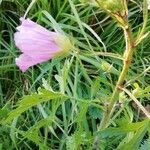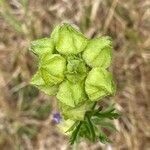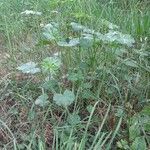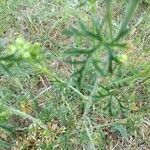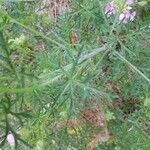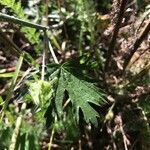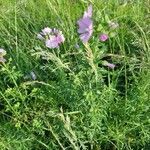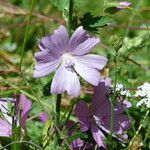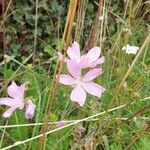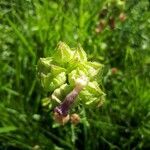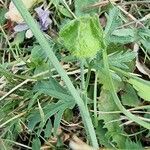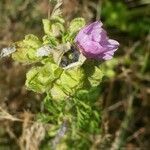Erect perennial herb. Stems moderately hairy with only simple hairs. Lvs sparsely to moderately hairy with simple hairs and rarely a few stellate hairs below, ± glabrous above; lower lvs reniform, shallowly 3-5-palmately lobed and crenate, 5-8 cm diam.; upper stem lvs deeply divided ± to base with usually 5, 2-pinnatifid lobes; ultimate segments ± linear; petiole 1-20 cm long; stipules linear to lanceolate, 5-8 mm long. Fls solitary in lower axils and racemose at apex; fruiting pedicels (8)-10-50 mm long; epicalyx segments linear or narrow-ovate, < calyx; calyx teeth ovate, acute to acuminate, moderately hairy with simple and stellate hairs, enlarged at fruiting; petals usually pink, sometimes white, 2-4× as long as calyx, (15)-20-30 mm long. Mericarps c. 15-20 per fr., densely hairy, smooth on back; edges rounded.
Erect perennial, 4–10 dm, rough-hairy; lvs orbicular in outline, 5–7-parted, the segments of the upper lvs again deeply pinnatifid; fls partly solitary on long pedicels fromthe upper axils, but chiefly crowded in terminal clusters; bractlets linear to narrowly lanceolate or oblanceolate, ciliate, glabrous or nearly so on the back; pet white to pale purple, triangular, 2–3.5 cm; mature carpels densely hairy, rounded on the back, not rugose; 2n=42. Native of Europe, escaped from cult., along roadsides and in waste places; Que. and N.S. to B.C., s. to Va. and Mo., more common northward. June–Sept.
A herb which keeps growing from year to year. It grows 60-100 cm high and spreads 45 cm wide. The leaves are mid green and narrow and finely cut. They are divided like fingers on a hand. They have a musk smell when crushed. The flowers are saucer shaped and rose-pink. They occur singly in the axils of the upper leaves. The petals are 20-35 mm long and twice as long as the sepals. The fruit are nutlets with long white hairs.
